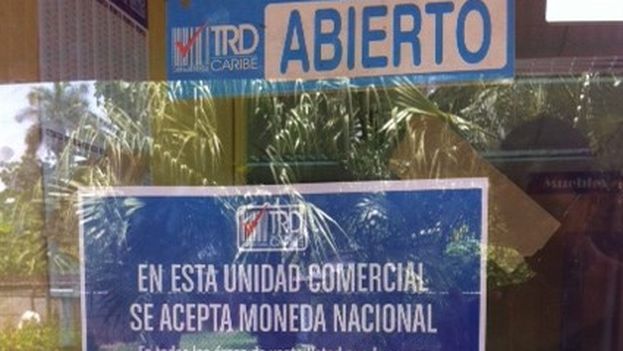
14YMEDIO, Yoani Sanchez, Havana, 19 September 2014 – At an artisan fair near the Malecon a seller offers unusual wallets. “Designed for a country with two currencies,” says the skilled merchant, while demonstrating their two separate compartments. Accustomed to living among convertible pesos (CUC) and Cuban pesos (CUP), we barely even notice any more the complications this duality brings us every day. The additional calculations, the long lines at the exchange kiosks, and the confusions in speech, requiring that we always make it clear if we are referring to CUPs or CUCs… are just some of them.
This mess has been slightly eased with the emergence of stores and markets where you can pay with both currencies. It took them more then twenty years, from the legalization of the dollar, to eliminate the problem of going to the nearest CADECA—currency exchange—to convert our Cuban pesos into chavitos (CUC). This could be a clear example of the slow pace at which economic relaxations are adopted in the country, if it weren’t for the fact that there are other aspects of national life where things move much more slowly.
A few years ago a group of dissidents launched the excellent slogan, “With the same money,” to demand a correspondence between the currency in which wages are paid and that needed to buy products as basic as oil, soap and milk. I remember that on several occasions some of those activists were at a café or restaurant and, after eating, they asked for the bill and paid with the devalued Cuban pesos. This action brought them arrests by the police, threats and even beatings.
Now the government has inverted the slogan and seems to be telling us, “for the same product.” It doesn’t matter if the bill is expressed in the banknotes without faces—the ones with monuments—which are the convertible pesos. It is now possible to also settle the bill with those other pieces of paper, bearing the sober glance of the Apostle—José Martí—or the stern face of Antonio Maceo. What does difference does it make what we pay with, or how many security threads this or that currency has? The central problem remains the divorce between the cost of living and wages.
A few days ago, official TV broadcast an extensive report about “the good popular reception given to the measure” of allowing us to pay for things in both currencies. The Commercial Director of the CIMEX chain of stores, Barbara Soto, referred to the gradual extension of the prerogative to a greater number of stores throughout the country. Some customers interviewed said that the price of every product should be visible both in CUPs and CUCs. However, the media report continually avoided the main questions: Why should a professional work three days to be able to buy a quart of oil? Until when will a worker need a full week’s wages to be able to buy two pounds of chicken?
Do we live better now because CUPs and CUCs are intermingled in the cash registers?
Right now it takes two working days to be able to acquire a package of hot dogs, while a tetrapack of milk can only be bought with the fruit of three days labor. This morning at the market a woman was looking at can of tomato sauce and seemed to be thinking, “For this I need to sweat eight hours for half a week.”
In a society with such great economic distortions, paper money has lost the capacity to express the value of merchandise. The illegal market, the massive inflow of remittances, the diversion of resources and the invisible capital of one’s political standing, completely alter the valuation of each product. To calculate the cost of living you need to have at hand equations that include the time and effort required to get something. How many hours do you have to work to buy a piece of cheese, a soft drink, bath soap. After how many trips will a bus driver be able to afford a beer?
It’s true that from now on the wallets offered by that artisan are becoming less necessary. However, the financial distortion we suffer hasn’t diminished with the newly adopted measure. Has something changed because we can indiscriminately hand the supermarket clerk convertible pesos or national money? Do we live better now because CUPs and CUCs are intermingled in the cash registers? The answer is no. A “no” that bears the watermark of reality and ink of emergency.
